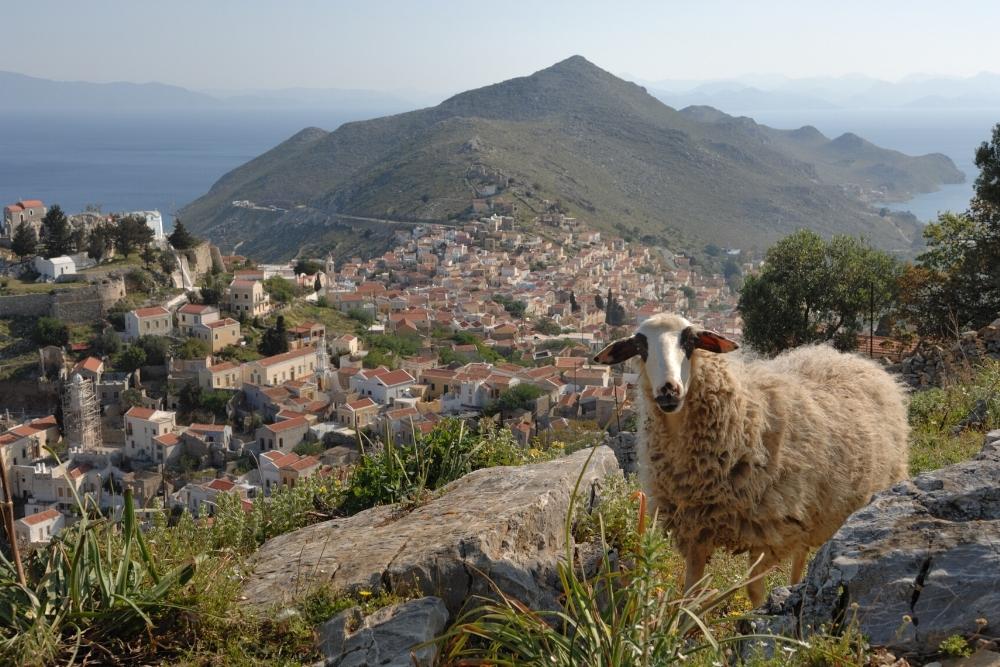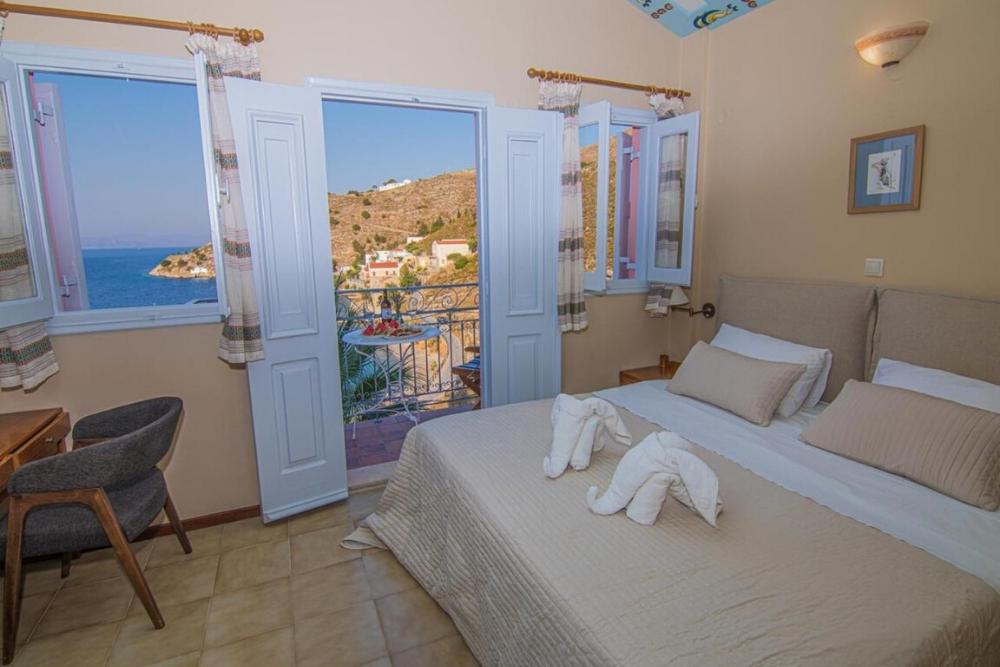From the first moment you enter Symi harbor, you are ‘struck’ by the kaleidoscope of colors that pour down from the hill overlooking the area. Colors are arranged on the neoclassical-style dwellings, with shades of terracotta, indigo, and ochre predominating. Symi is a small island, part of the Dodecanese archipelago, located at the node of Rhodos and chosen by tourists mainly for the beauty of its towns and villages.
Symi has an exceptional atmosphere. First of all, because there are very few cars on the island, which makes it extremely quiet, not to say romantic. Symi also offers one of the most traditional Greek cultures, integrated into a special hospitality. And for the more ‘walkers’, Symi can always be an excellent starting point for exploring this part of the Aegean.
Symi’s economy has always been based on sailing, fishing, wine, sponge, and boat production, which is still the case today, although tourism has become the predominant industry in Symi.
- History of Symi Island
- What to do and see on Symi Island
- Map with main tourist attractions in Symi Island (zoom for details)
- Gialos and Chorio
- Monastery of Archangel Michael Panormitis
- The 12 Emporios caves
- Venetian castle
- The beaches of Symi
- Best hotels in Symi
- Best restaurants in Symi
- How to get to Symi
- Pin it!
History of Symi Island

In Greek mythology, we find the island of Symi as the birthplace of the Graces, the three goddesses of charm, femininity, beauty, creativity, and fertility. Although in ancient times, the island was known as Aigli and Metapontis, its name comes from the nymph Syme. Although Pliny the Elder, and several other writers after him, thought the origin was from the word monkey, meaning ape.
In Homer’s Iliad, Symi is mentioned as the territory of King Nireus, who fought in the Trojan War on the side of the Greeks. Little is known about Symi until the 14th century, but archaeological finds – including the ruins of a fortress – have revealed that it was continuously inhabited. Symi was part of the Roman Empire, then the Byzantine Empire, until the Knights of St. John conquered it in 1373.
Several centuries of prosperity followed for Symi, as the island was on an important trade route that was heavily exploited until the 19th century. This was despite the fact that it came (along with neighboring Rhodos) under the rule of the Ottoman Empire in 1522, during which time it was called Sömbeki. It then took part in the War of Independence (1821-29) but was left outside the new Greek state, remaining Ottoman territory. Until 1912, when the Dodecanese archipelago declared its independence from the Turks and was immediately occupied by the… Italians. Symi remained under the Italian flag until 1943 when it was occupied by the Nazis. When the war ended, the island reverted to the British for a few years and then came under the Greek flag for good in 1948.


So a rich history for Symi, which has become an increasingly popular tourist destination in the years of peace, especially for Italians and British. The influx of tourists has led to the renovation of many houses – a lot of them destroyed by the bombs during the Second World War. Work has intensified over the past two decades so that today Symi’s architecture is truly spectacular. And tourists discover Symi’s traditionally decorated, antique-style houses and apartments at absolutely reasonable prices.
What to do and see on Symi Island
Those inspired to choose Symi as their holiday destination will immediately notice how different this island is from the others around it. First of all, the blue-white color of the houses that tourists are used to in the Cyclades, for example, is replaced by that burst of color we talked about above, which has become a real coat of arms for Symi.
Map with main tourist attractions in Symi Island (zoom for details)
Then, Symi is considered a paradise for snorkelers. The water’s clarity is famous due to photos of boats that seem to float on its surface. The scent of oregano and rosemary will accompany you everywhere in Symi, and the restaurants and tavernas along the seashore offer delicious dishes, many not found on many Greek islands, such as chickpeas with dill, cabbage-sheet rolls with bean stuffing, or the excellent miniature prawns (garadaki symiako) caught right off the island’s coast and eaten straight off the grill, with lemon and shells.
You can visit Symi on a day trip from Rhodos, but the recommendation is to take the courage to take a holiday to discover the beauty of this island ‘in full’:
Gialos and Chorio

The main town of Symi (which, taken as a whole, is also called Symi) is divided into two areas. The first is the port of Gialos, with pastel-colored houses spilling down the hill in a cavalcade of hues. Then there’s Chorio, or the old town, at the top, which can be reached by climbing 500 steps, an hourly bus, or a… donkey.

In Gialos harbor, you will admire the buildings of the Police and the old Post Office, the Cathedral of St. John the Baptist (built in 1838), the House of the Widow, the fish market, the stone bridge, the statue of the little fisherman, the clock dating from 1881 and the old harbor in the Harani district. Pontikokastro is also one of the island’s oldest monuments.



In Chorio, on the other hand, you’ll reach Kali Strata, the most beautiful and most prosperous part of the village. Spetsaria, the old pharmacy, the Chatziagapitou-Xatziioannou house, the Farmakides house (the Museum of Archaeology and Folklore) with collections including statue heads and objects from the post-Christian period, Byzantine icons, etc.) – these are all things to see and visit here.
Monastery of Archangel Michael Panormitis

The Monastery of Archangel Michael Panormitis is the most important religious monument in Symi, and the place of worship also has a hostel that can accommodate up to 500 people. It is not known exactly when the monastery was built, but it existed in the 15th century, according to an old manuscript. The interior is decorated with paintings from the Byzantine period by local hagiographers Nikitas and Michaelos Karakostidis, with an image of the archangel Michael appearing on one of the frescoes.
There are also two museums in the monastery courtyard, one housing silver icons, epitaphs, ecclesiastical vestments, and other religious objects, the other exhibiting objects belonging to the folk culture or everyday life of the island of Symi. Every year on 8 November, a religious festival is held at the monastery celebrating, of course, the Holy Archangel Michael.
The 12 Emporios caves
The 12 caves are one of the most bizarre and enigmatic attractions on Symi Island. The caves are located in Nimborio, and the 12 natural domes apparently served in Byzantine times as study rooms for painting and sculpture. Another view is that they were actually used as catacombs.
Venetian castle

The Knights of Joan built the castle on the island of Symi in the 14th century; it ‘shared’ a wall with the Byzantine castle, the ruins of which are still visible. Situated on the highest point of Chorio, the castle was meant to protect the island against pirate raids and did its job well before falling to the Ottomans in 1522. Don’t expect to see a fortress in the ‘flesh’, just ruins, but what makes the place worth visiting is the superb views it offers, especially from the small chapel of the Virgin Mary.
The beaches of Symi
Being a small island, Symi doesn’t have that many beaches. However, Symi’s beaches, which stretch into charming coves, welcome their guests with sufficient facilities – the case of Nimborio, Nos, and Pedi beaches. Others are secluded and not at all crowded for those seeking absolute tranquillity.
Nos beach

Nos is the closest beach to Ano Symi, meaning it’s a 15-minute walk from the harbor and the clock tower. It’s not a beach overflowing with privacy; quite the opposite. And that’s because the clear, blue waters, sun loungers, bar, and nearby restaurant recommend it as an extremely popular one. Nos is also the only place on Symi Island where you can rent jet skis.
Nimborio Beach

Located 3km northwest of Symi town, Nimborio (or Emborios, or Nimporios) beach contributes to the island’s charm in spades. It’s generally a quiet, pebbly beach where tourists can sit in the sun or in the shade of trees, bathing in the crystal-clear waters that surround it. Nimborio also offers relaxing morning walks.
Pedi Beach

Just a few minutes walk from the capital, the village of Pedi is a magnet for visitors, mainly because of its beaches but also because of the remains of early Christian churches. There are several small, sandy beaches in Pedi. The main beach has sun loungers and umbrellas for hire, and there are also several tavernas where you can have lunch or dinner.
Other beaches in Symi
If you are not satisfied, you can look for these beach alternatives: Gialos beach, Panormitis beach, Marathounda beach, Agia Marina beach.
Best hotels in Symi
Pedi Beach Hotel ****
Booking rating: 9.2

Pedi Beach Hotel is set in a quiet bay between Agia Marina and Agios Nicolaos beaches, lapped by crystal clear waters. It welcomes its guests with a warm atmosphere and well-appointed rooms with sea views. Free and spacious parking.
Niriides Hotel Apartments ***
Booking Score: 9,5

Located in Nimporios, 70 meters from the beach, the Niriides apartment complex (there are four buildings built in the island’s architectural style) offers rooms with sea or garden views, featuring a kitchenette, air conditioning, and internet.
Iapetos Village ****
Booking Score: 8.8

Centrally located in the town of Symi, Iapetos Village is surrounded by a 500 sqm palm garden. The complex has a swimming pool, sauna and pool bar, rooms with pool or garden view, free internet. The harbor is 200 meters away, and Nos beach is 1.3 km away.
Best restaurants in Symi

The Secret Garden
If you’re hungry after wandering the capital’s backstreets, you can opt for a meal at The Secret Garden. The menu is Greek and Mediterranean, with the main recommendations being lamb, octopus, and squid. Don’t skip dessert, though. The apple pie is said to be excellent. Live music plays in the restaurant in the evenings.
Haritomeni Taverna
Haritomeni’s Greek and Mediterranean menu never disappoints. Come here to try the smoked octopus, baked potatoes, and courgettes. And according to those who have visited, the wine is outstanding.
Zoe’s Taverna
The best place to eat in Kali Strata. Delicious tasting Greek dishes, among which salads, fish cakes, and prawns stand out. At Zoe’s you can enjoy a beautiful view while you eat. Low prices and friendly atmosphere.
How to get to Symi

Symi Island is not served by an airport. There are ferries from Piraeus port to Symi three times a week, but the long-distance makes the journey up to 20 hours. It’s most convenient to fly into Rhodos, the neighboring island, then take the ferry to Symi from there – a distance covered in about an hour and a half. Otherwise, Symi is also connected by ferry to the other surrounding islands – Patmos, Leros, Tilos, and Kalymnos.
Pin it!


You may also like: Aegina Island – a vacation in the Saronic archipelago




